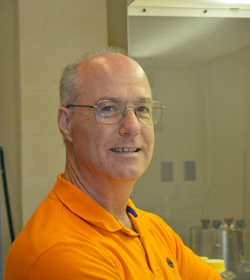
Dr. William Henley
Professor Emeritus
Dept. of Plant Biology, Ecology, and Evolution
301 Physical Sciences, Stillwater, OK 74078-3013, USA
bill.henley@okstate.edu
View my video on Blue-Green Algae here
Research
My core interests are in the area of algal stress physiology and algal biofuels.
Current research focuses on the project Continuous Cultures of Algae: Basic Research Toward Biofuels funded by the Oklahoma Center for the Advancement of Science and Technology (OCAST). We are exposing pure and mixed cultures of salt tolerant green algae, diatoms and cyanobacteria to variable temperature, salinity, and nutrients to test the hypotheses that mixtures of the algal classes will maintain higher biomass, productivity and yields of neutral lipids (the direct feedstock for biodiesel) compared to monocultures. Longer term goals include (1) design of process control mechanisms and algorithms based on an empirical understanding of community dynamics and algal physiology derived from this project, and (2) scale-up to outdoor mesocosms.
Recent past research focused on the phylogeny and physiological ecology of broadly halotolerant algae and cyanobacteria from the Salt Plains National Wildlife Refuge near Cherokee in northwestern Oklahoma. This work comprised two NSF-funded projects:
Collaborative Research: Salt Plains Microbial Observatory(MCB-0132097).
LExEn: Response of photosynthetic microbes of the Salt Plains National Wildlife Refuge to dynamic extreme conditions (MCB-9978203).
Current research directions and possible thesis/dissertation topics include:
Growing algae for biofuels: optimizing growth and yield conditions, comparing productivity/yields and/or stablility of pure single isolates vs. communities of mixed genetic strains (addresses fundamental ecological concepts)
Global phylogeography of the halophilic alga Dunaliella (addresses fundamental ecological concepts)
Demonstrating and characterizing obligate or facultative interactions between (halophilic) algae/cyanobacteria and heterotrophic bacteria/archaea (addresses fundamental ecological concepts)
Characterization of putatively primitive isolates of cyanobacteria from the Great Salt Plains: morphology, physiology and molecular genetics
Physiological ecology of aquatic plants and algae/phytoplankton in local lakes and the the Great Salt Plains
Recent Publications
Franks, D.T., T.J. Sabella & W.J. Henley. 2022. Minimum nitrogen cell quota for maximal growth rate in cycloturbidostat cultures of Picochlorum oklahomense. Algal Research 67:102818. https://doi.org/10.1016/j.algal.2022.102818
Henley, W.J. 2019. The past, present and future of algal continuous cultures in basic research and commercial applications. Algal Research (in press). https://doi.org/10.1016/j.algal.2019.101636 (page proofs)
Henley, W.J., M. Cobbs, L. Novoveská & M.A. Buchheim. 2018. Phylogenetic analysis of Dunaliella (Chlorophyta) emphasizing new benthic and supralittoral isolates from Great Salt Lake. J. Phycol. 54: 483-493. https://onlinelibrary.wiley.com/doi/abs/10.1111/jpy.12747 https://rdcu.be/XUmU
Novoveská, L., D.T. Franks, T.A. Wulfers & W.J. Henley. 2016. Stabilizing continuous poly-cultures of microalgae. Algal Research 13:126-133. http://dx.doi.org/10.1016/j.algal.2015.11.021
Novoveská, L. & W.J. Henley. 2014. Lab-scale testing of a two-stage continuous culture system for microalgae. Indust. Biotechnol. 10:228-236. http://dx.doi.org/10.1089/ind.2013.0034
Henley, W.J., R.W. Litaker, L. Novoveská, C.S. Duke, H.D. Quemada and R.T. Sayre. 2012. Initial risk assessment of genetically modified (GM) algae for commodity-scale biofuel cultivation. Algal Research 2:66-77. http://www.sciencedirect.com/science/article/pii/S2211926412000549 (Also see this related editorial: http://www.sciencedirect.com/science/article/pii/S2211926413000076#)
Buchheim, M.A., A.E. Kirkwood, J.A. Buchheim, B. Verghese and W.J. Henley. 2010. Hypersaline soil supports a diverse community of Dunaliella(Chlorophyceae). J. Phycol. 46:1038-1047.
Kirkwood, A.E., J.A. Buchheim, M.A. Buchheim and W.J. Henley. 2008. Cyanobacterial diversity and halotolerance in a variable hypersaline environment. Microb. Ecol.55:453-465.
Henley, W.J., J. Milner, J. Kvíderová, A.E. Kirkwood and A.T. Potter. 2007. Life in variable salinity: algae of the Great Salt Plains of Oklahoma, U.S.A. In: J. Sekbach [ed.] Algae and Cyanobacteria in Extreme Environments, pp. 683-694. Springer, Berlin.
Kirkwood, A.E. and W. J. Henley. 2006. Algal community dynamics and halotolerance in a terrestrial, hypersaline environment. J. Phycol. 42:537-547.
Potter, A.T., M.W. Palmer and W.J. Henley. 2006. Diatom genus diversity and assemblage structure in relation to salinity at the Salt Plains National Wildlife Refuge, Alfalfa County, Oklahoma. Amer. Midl. Nat. 156:65-74.
Kvíderová, J. and W.J. Henley. 2005. The effect of ampicillin plus streptomycin on growth and photosynthesis of two halotolerant chlorophyte algae.J. Appl. Phycol. 17:301-307.
Major, K.M., A.E. Kirkwood, C.S. Major, J.W. McCreadie and W. J. Henley. 2005. In situ studies of algal biomass in relation to physicochemical characteristics of the Salt Plains National Wildlife Refuge, Oklahoma, USA. Saline Systems 1:11.
